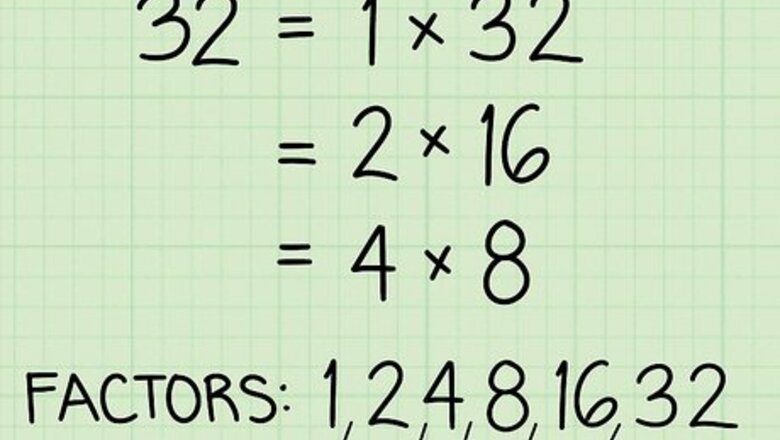
views
a
x
+
b
{\displaystyle ax+b}
. The first term always includes a variable, while the second term may or may not. Factoring a binomial means finding simpler terms that, when multiplied together, produce that binomial expression, which helps you solve it or simplify it for further work.
Factoring Binomials
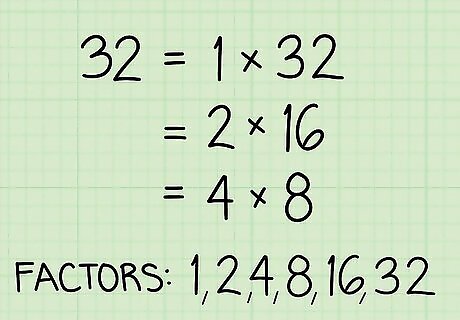
Review the basics of factoring. Factoring is when you break a large number down into it's simplest divisible parts. Each one of these parts is called a "factor." So, for example, the number 6 can be evenly divided by four different numbers: 1, 2, 3, and 6. Thus, the factors of 6 are 1, 2, 3, and 6. The factors of 32 are 1, 2, 4, 8, 16, and 32 Both "1" and the number you're factoring are always factors. So, the factors of a small number, like 3, would simply be 1 and 3. Factors are only the perfectly divisible numbers, or "whole" numbers. You could divide 32 by 3.564, or 21.4952, but this won't lead to a factor, just another decimal.
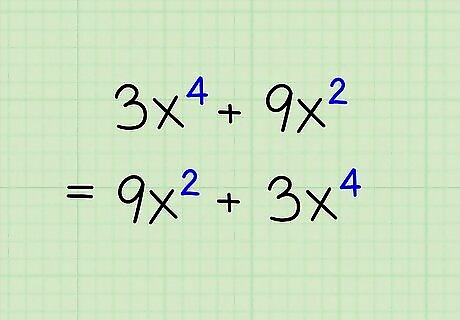
Place the binomial's terms in order to make them easier to read. A binomial is simply the addition or subtraction of two numbers, at least one of which contains a variable. Sometimes these variables have exponents, like x 2 {\displaystyle x^{2}} x^{2} or 5 y 4 {\displaystyle 5y^{4}} 5y^{4}. When first factoring binomials, it can help to reorder equations with ascending variable terms, meaning the biggest exponent is last. For example: 3 t + 6 {\displaystyle 3t+6} 3t+6 → 6 + 3 t {\displaystyle 6+3t} 6+3t 3 x 4 + 9 x 2 {\displaystyle 3x^{4}+9x^{2}} 3x^{4}+9x^{2} → 9 x 2 + 3 x 4 {\displaystyle 9x^{2}+3x^{4}} 9x^{2}+3x^{4} x 2 − 2 {\displaystyle x^{2}-2} x^{2}-2 → − 2 + x 2 {\displaystyle -2+x^{2}} -2+x^{2} Note how the negative sign stays in front of the 2. If a term is subtracted, just keep the negative in front of it.
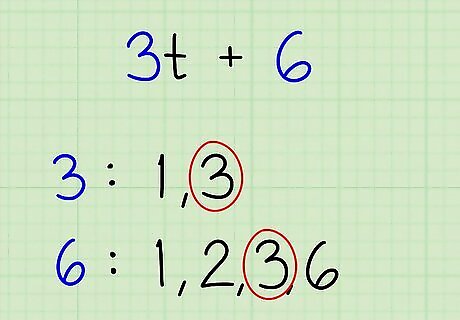
Find the greatest common factor of both terms. This means you find the highest possible number that both parts of the binomial are divisible by. If you're struggling, simply factor both numbers on their own, then see what the highest matching number is. For example: Practice Problem: 3 t + 6 {\displaystyle 3t+6} 3t+6. Factors of 3: 1, 3 Factors of 6: 1, 2, 3, 6. The greatest common factor is 3.
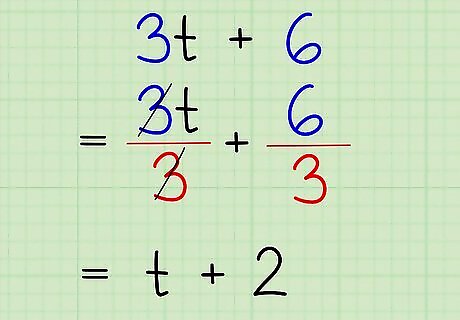
Divide the greatest common factor from each term. Once you know your common factor, you need to remove it from each term. Note, however, that you're simply breaking the terms down, turning each term into a small division problem. If you did it right, both equations will share your factor: Practice Problem: 3 t + 6 {\displaystyle 3t+6} 3t+6. Find greatest common factor: 3 Remove factor from both terms: 3 t 3 + 6 3 = t + 2 {\displaystyle {\frac {3t}{3}}+{\frac {6}{3}}=t+2} {\frac {3t}{3}}+{\frac {6}{3}}=t+2
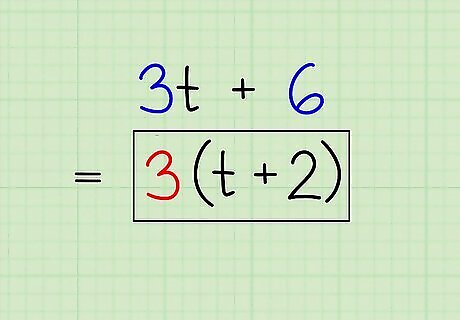
Multiply your factor by the resulting expression to finish. In the last problem, you removed a 3 to get t + 2 {\displaystyle t+2} t+2. But you weren't just getting rid of the three entirely, simply factoring it out to simplify things. You can't just erase numbers without putting them back! Multiply your factor by the expression to finally finish. For example: Practice Problem: 3 t + 6 {\displaystyle 3t+6} 3t+6 Find greatest common factor: 3 Remove factor from both terms: 3 t 3 + 6 3 = t + 2 {\displaystyle {\frac {3t}{3}}+{\frac {6}{3}}=t+2} {\frac {3t}{3}}+{\frac {6}{3}}=t+2 Multiple factor by new expression: 3 ( t + 2 ) {\displaystyle 3(t+2)} 3(t+2) Final Factored Answer: 3 ( t + 2 ) {\displaystyle 3(t+2)} 3(t+2)
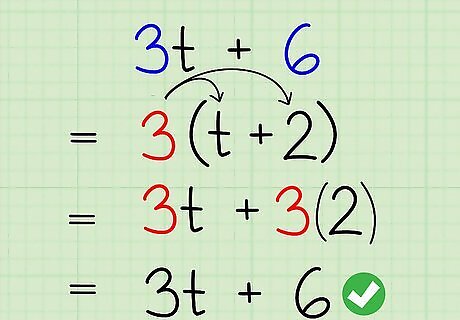
Check your work by multiplying it all back out to the original equation. If you did everything correctly, checking that you got it right should be easy. Simply multiply your factor by both individual parts in the parenthesis. If it matches the original, unfactored binomial then you did it all correctly. From start to finish, solve the expression 12 t + 18 {\displaystyle 12t+18} 12t+18 to practice: Reorganize terms: 18 + 12 t {\displaystyle 18+12t} 18+12t Find greatest common denominator: 6 {\displaystyle 6} 6 Remove factor from both terms: 18 t 6 + 12 t 6 = 3 + 2 t {\displaystyle {\frac {18t}{6}}+{\frac {12t}{6}}=3+2t} {\frac {18t}{6}}+{\frac {12t}{6}}=3+2t Multiple factor by new expression: 6 ( 3 + 2 t ) {\displaystyle 6(3+2t)} 6(3+2t) Check Answer: ( 6 ∗ 3 ) + ( 6 ∗ 2 t ) = 18 + 12 t {\displaystyle (6*3)+(6*2t)=18+12t} (6*3)+(6*2t)=18+12t
Factoring Binomials to Solve Equations
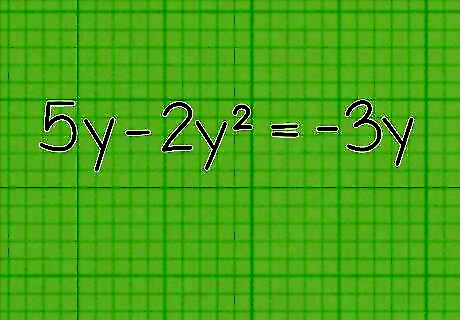
Use factoring to simplify equations and make them easier to solve. When solving an equation with binomials, especially complex binomials, it can seem like there is no way everything will match. For example, try to solve 5 y − 2 y 2 = − 3 y {\displaystyle 5y-2y^{2}=-3y} 5y-2y^{2}=-3y. One way to solve it, especially with exponents, is to factor first. Practice Problem: 5 y − 2 y 2 = − 3 y {\displaystyle 5y-2y^{2}=-3y} 5y-2y^{2}=-3y Remember that binomials must only have two terms. If there are more than two terms you can learn to solve polynomials instead.
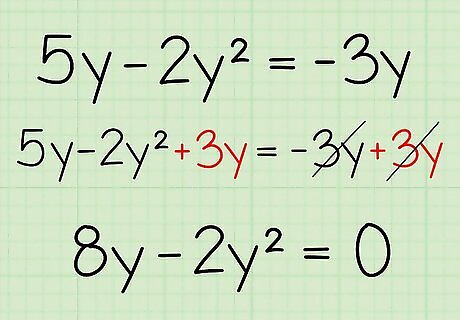
Add and subtract so that one side of the equation is equal to zero. This whole strategy relies on one of the most basic facts of math: anything multiplied by zero must equal zero. So if you equation equals zero, then one of your factored terms must equal zero! To get started, add and subtract so one side equals zero. Practice Problem: 5 y − 2 y 2 = − 3 y {\displaystyle 5y-2y^{2}=-3y} 5y-2y^{2}=-3y Set to Zero: 5 y − 2 y 2 + 3 y = − 3 y + 3 y {\displaystyle 5y-2y^{2}+3y=-3y+3y} 5y-2y^{2}+3y=-3y+3y 8 y − 2 y 2 = 0 {\displaystyle 8y-2y^{2}=0} 8y-2y^{2}=0
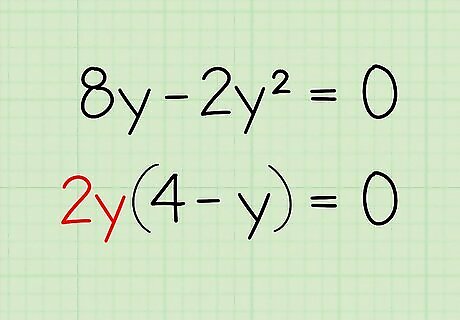
Factor the non-zero side just like normal. At this point, you can pretend the other side doesn't exist for a step. Just find the greatest common factor, divided it out, and then create your factored expression. Practice Problem: 5 y − 2 y 2 = − 3 y {\displaystyle 5y-2y^{2}=-3y} 5y-2y^{2}=-3y Set to Zero: 8 y − 2 y 2 = 0 {\displaystyle 8y-2y^{2}=0} 8y-2y^{2}=0 Factor: 2 y ( 4 − y ) = 0 {\displaystyle 2y(4-y)=0} 2y(4-y)=0
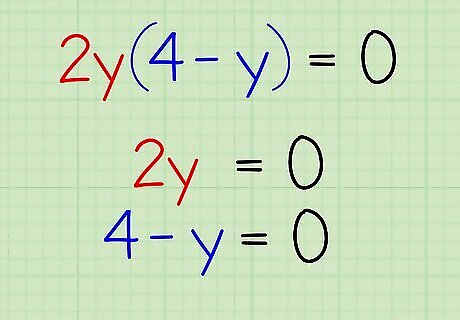
Set both inside and outside the parenthesis as equal to zero. In the practice problem you are multiplying 2y by 4 - y, and it must equal zero. Since anything multiplied by zero equals zero, this means either 2y or 4 - y must be 0. Create two separate equations to figure out what y must be for either side to equal zero. Practice Problem: 5 y − 2 y 2 = − 3 y {\displaystyle 5y-2y^{2}=-3y} 5y-2y^{2}=-3y Set to Zero: 8 y − 2 y 2 + 3 y = 0 {\displaystyle 8y-2y^{2}+3y=0} 8y-2y^{2}+3y=0 Factor: 2 y ( 4 − y ) = 0 {\displaystyle 2y(4-y)=0} 2y(4-y)=0 Set both parts to 0: 2 y = 0 {\displaystyle 2y=0} 2y=0 4 − y = 0 {\displaystyle 4-y=0} 4-y=0
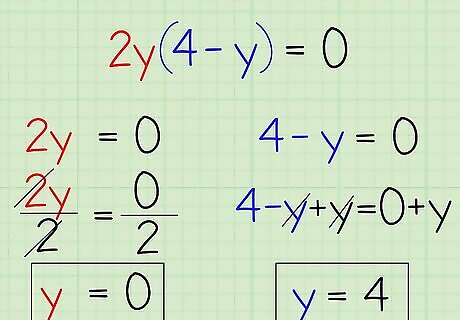
Solve both equations for zero to get your final answer or answers. You might have one answer, or more than one. Remember, only one side has to equal zero, so you might get a few different values of y that solve the same equation. For the end of the practice problem: 2 y = 0 {\displaystyle 2y=0} 2y=0 2 y 2 = 0 2 {\displaystyle {\frac {2y}{2}}={\frac {0}{2}}} {\frac {2y}{2}}={\frac {0}{2}} y = 0 4 − y = 0 {\displaystyle 4-y=0} 4-y=0 4 − y + y = 0 + y {\displaystyle 4-y+y=0+y} 4-y+y=0+y y = 4
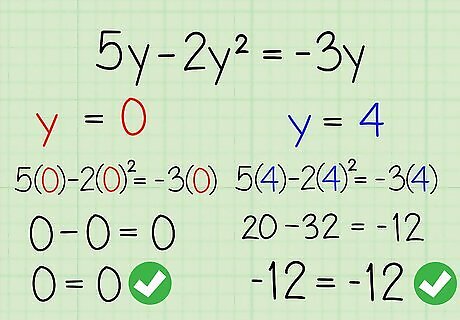
Plug your answers back in to ensure that they work. If you got the right values for y then you should be able to use them to solve the equation. It is simple as trying each value of y in place of the variable, as shown. Since the answer were y = 0 and y = 4: 5 ( 0 ) − 2 ( 0 ) 2 = − 3 ( 0 ) {\displaystyle 5(0)-2(0)^{2}=-3(0)} 5(0)-2(0)^{2}=-3(0) 0 + 0 = 0 {\displaystyle 0+0=0} 0+0=0 0 = 0 {\displaystyle 0=0} 0=0 This answer is correct 5 ( 4 ) − 2 ( 4 ) 2 = − 3 ( 4 ) {\displaystyle 5(4)-2(4)^{2}=-3(4)} 5(4)-2(4)^{2}=-3(4) 20 − 32 = − 12 {\displaystyle 20-32=-12} 20-32=-12 − 12 = − 12 {\displaystyle -12=-12} -12=-12 This answer is also correct.
Handling Trickier Problems
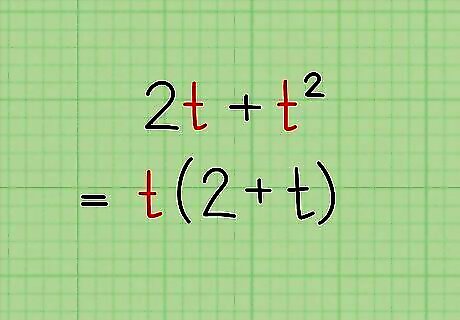
Remember that variables also count as factors, even with exponents. Remember, factoring is finding out what numbers can divide into the whole. The expression x 4 {\displaystyle x^{4}} x^{4} is another way of saying x ∗ x ∗ x ∗ x {\displaystyle x*x*x*x} x*x*x*x. This means you can factor out each x if the other term has one as well. Treat variables no different from a normal number. For example: 2 t + t 2 {\displaystyle 2t+t^{2}} 2t+t^{2} can be factored, because both terms contain a t. Your final answer would be t ( 2 + t ) {\displaystyle t(2+t)} t(2+t) You can even pull out multiple variables at once. For example, in x 2 + x 4 {\displaystyle x^{2}+x^{4}} x^{2}+x^{4} both terms contain the same x 2 {\displaystyle x^{2}} x^{2}. You can factor to x 2 ( 1 + x 2 ) {\displaystyle x^{2}(1+x^{2})} x^{2}(1+x^{2})
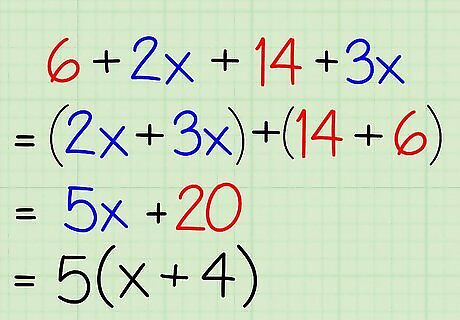
Recognize unsimplified binomials by combining like terms. Take, for example, the expression 6 + 2 x + 14 + 3 x {\displaystyle 6+2x+14+3x} 6+2x+14+3x. This may seem like it has four terms, but look closely and you'll realize there are really only two. You can add like terms, and since both the 6 and 14 have no variable, and the 2x and 3x share the same variable, these can both be combined. Factoring is then easy: Original Problem: 6 + 2 x + 14 + 3 x {\displaystyle 6+2x+14+3x} 6+2x+14+3x Reorganize terms: 2 x + 3 x + 14 + 6 {\displaystyle 2x+3x+14+6} 2x+3x+14+6 Combine like terms: 5 x + 20 {\displaystyle 5x+20} 5x+20 Find greatest common factor: 5 ( x ) + 5 ( 4 ) {\displaystyle 5(x)+5(4)} 5(x)+5(4) Factor: 5 ( x + 4 ) {\displaystyle 5(x+4)} 5(x+4)
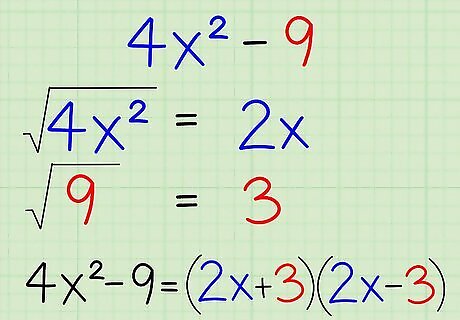
Recognize the special "difference of perfect squares." A perfect square is a number whose square root is a whole number, like 9 {\displaystyle 9} 9 ( 3 ∗ 3 ) {\displaystyle (3*3)} (3*3), x 2 {\displaystyle x^{2}} x^{2} ( x ∗ x ) {\displaystyle (x*x)} (x*x), or even 144 t 2 {\displaystyle 144t^{2}} 144t^{2} ( 12 t ∗ 12 t ) {\displaystyle (12t*12t)} (12t*12t) If your binomial is a subtraction problem with two perfect squares, like a 2 − b 2 {\displaystyle a^{2}-b^{2}} a^{2}-b^{2}, you can simply plug them into this formula: Difference of perfect squares formula: a 2 − b 2 = ( a + b ) ( a − b ) {\displaystyle a^{2}-b^{2}=(a+b)(a-b)} a^{2}-b^{2}=(a+b)(a-b) Practice Problem: 4 x 2 − 9 {\displaystyle 4x^{2}-9} 4x^{2}-9 Find square roots: 4 x 2 = 2 x {\displaystyle {\sqrt {4x^{2}}}=2x} {\sqrt {4x^{2}}}=2x 9 = 3 {\displaystyle {\sqrt {9}}=3} {\sqrt {9}}=3 Plug squares into formula: 4 x 2 − 9 = ( 2 x + 3 ) ( 2 x − 3 ) {\displaystyle 4x^{2}-9=(2x+3)(2x-3)} 4x^{2}-9=(2x+3)(2x-3)
Learn to breakdown the "difference of perfect cubes." Just like the perfect squares, this is a simple formula for when you have two cubed terms subtracted by each other. For example, a 3 − b 3 {\displaystyle a^{3}-b^{3}} a^{3}-b^{3}. Just like before, you simply find the cubed root of each, plugging them into a formula: Difference of perfect cubes formula: a 3 − b 3 = ( a − b ) ( a 2 + a b + b 2 ) {\displaystyle a^{3}-b^{3}=(a-b)(a^{2}+ab+b^{2})} a^{3}-b^{3}=(a-b)(a^{2}+ab+b^{2}) Practice Problem: 8 x 3 − 27 {\displaystyle 8x^{3}-27} 8x^{3}-27 Find cubed roots: 8 x 3 3 = 2 x {\displaystyle {\sqrt[{3}]{8x^{3}}}=2x} {\sqrt[ {3}]{8x^{3}}}=2x 27 3 = 3 {\displaystyle {\sqrt[{3}]{27}}=3} {\sqrt[ {3}]{27}}=3 Plug cubes into formula: 8 x 3 − 27 = ( 2 x − 3 ) ( 4 x 2 + 6 x + 9 ) {\displaystyle 8x^{3}-27=(2x-3)(4x^{2}+6x+9)} 8x^{3}-27=(2x-3)(4x^{2}+6x+9)
Know that the sum of perfect cubes also fits in a formula. Unlike the difference of perfect squares, you can easily find added cubes too, like a 3 + b 3 {\displaystyle a^{3}+b^{3}} a^{3}+b^{3}, with a simple formula. It's almost the exact same as above, just with some pluses and minuses flipped. The formula is just as easy as the other two, and all you have to do is recognize the two cubes in the problem to use it: Sum of perfect cubes formula: a 3 + b 3 = ( a + b ) ( a 2 − a b + b 2 ) {\displaystyle a^{3}+b^{3}=(a+b)(a^{2}-ab+b^{2})} a^{3}+b^{3}=(a+b)(a^{2}-ab+b^{2}) Practice Problem: 8 x 3 − 27 {\displaystyle 8x^{3}-27} 8x^{3}-27 Find cubed roots: 8 x 3 3 = 2 x {\displaystyle {\sqrt[{3}]{8x^{3}}}=2x} {\sqrt[ {3}]{8x^{3}}}=2x 27 3 = 3 {\displaystyle {\sqrt[{3}]{27}}=3} {\sqrt[ {3}]{27}}=3 Plug cubes into formula: 8 x 3 − 27 = ( 2 x + 3 ) ( 4 x 2 − 6 x + 9 ) {\displaystyle 8x^{3}-27=(2x+3)(4x^{2}-6x+9)} 8x^{3}-27=(2x+3)(4x^{2}-6x+9)




















Comments
0 comment